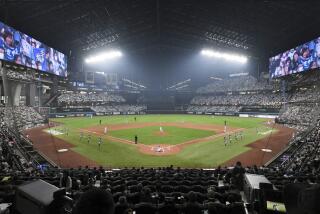Japanese Visit Hottest Remodeling Market
They are all conservatively dressed and travel in groups, each person usually carrying a camera. Some also carry briefcases.
Yes, the reference is to Japanese business groups. So many of them have come and gone that blase locals really don’t pay that much attention to them any more. But downtown workers wonder how many pictures they have taken of our venerable City Hall.
A recent 47-member delegation came for a very specific reason. This group included home builders, home remodelers and building products dealers, here to learn and see how the nation’s hottest remodeling market functions.
As reported recently on our home improvement page, Los Angeles is the country’s top remodeling market, handling a dollar volume of $611 million in 1986, with job increments ranging upward to $100,000.
Throughout the nation this year, jobs in the burgeoning residential remodeling field are are easily expected to pass last year’s $92-billion mark, which was more than double the $45-billion mark just five years ago.
Having come to the right place, the contingent visited two of the prominent firms in the remodeling contracting business, Blue Ribbon Builders in Orange and L. J. Hausner Construction in Anaheim.
Of particular and current international interest was their concern about materials they can import from the United States and how they can be applied in their island homeland. Ten of the visitors’ firms already buy some building materials from U. S. sources and expect to increase that volume sharply in the near future, they indicated to translators.
Some background information to explain further their keen interest in the remodeling field is offered by Noriko Yamamoto, president of Marina del Rey-based Global Link, an international liaison firm specializing in providing information, market research and public relations to “companies on both sides of the Pacific.”
She notes that Japan has been building more than 1 million housing units annually since 1967, in a country which is only one-twenty-fifth the size of the U. S., with a habitable area of only 21% compared with 49% in the United States and with about half the population that we have. “Well, the answer to that is high-density communities with houses built on small lots--try 1,000 to 1,500 square feet. Nevertheless, in 1986 Japan built about 1.36-million housing units and this year they are expecting somewhere around 1.7-million housing starts.
That figure will pass over what is expected here in the United States for 1987, about 1.6-million starts,” she said.
“The force behind this robust activity in Japan’s housing industry is the government’s thrust of boosting the domestic demands so that the Japanese economy and businesses could rely more heavily on its domestic markets, which may reduce the need to export her products overseas.
“This may be a rather simplistic explanation but it is obvious that ever since the Japan-U.S. trade imbalance grew uncomfortably enormous for both countries, the Japanese government gave clear signs of expanding the domestic consumption.
“To boost the domestic demands, the government picked the housing industry there as its banner carrier. The already lower than U.S. mortgage rates were even further lowered,” she said.
“Currently, the Japan Housing Loan Corp.’s 30-year fixed rate is 4.7% and commercial banks’ lending rate for the same are about 6.3%. Although you cannot write off the mortgage interest payment against your income as in the U.S., these low rates certainly helped encourage homeownership (in Japan) immensely.
“Thus, many of the homebuilding companies in Japan are enjoying 30% to 40% increases in sales this year. As a result, there are now tremendous shortages in both labor and materials. Hence, the prices of those have skyrocketed during the past year.”
Some of those in the tour group told Yamamoto, who helped arrange the visit, that currently the average home-building cost in Japan is about $87 a square foot. Here, the cost would be about one-half of that, excluding the land.
“They claim that the building cost went up nearly 50% in just one year due to the heavy demand,” she said. “So you see why the U.S. building materials present new attractiveness to the Japanese home builders.”
Yamamoto, a native of Japan, was graduated from USC with a degree in international trade and commerce and founded Global Link in 1975. Her clients include many major building and real estate industry leaders in Japan as well as prominent American firms and she has worked closely with the Washington-based National Assn. of Home Builders.
During the visit to home construction and home remodeling sites, the group showed particular interest in how the various building materials are incorporated into room additions.
They also saw work under way where additions were being made to one- and two-story dwellings, how the foundation or footing is reinforced when adding a second floor, how dual glazing in window products helps conserve energy, types of insulation used in walls, ceilings and flooring or between interior walls and the application of masonite as siding to the exterior of a house.
But none of this new-found interest in home remodeling is expected to diminish the overall interest of Japanese investors in American properties.
“In the face of the stock market collapse, real estate presents . . . a stabler, safer, surer product to invest in,” she added.
But, most likely, we’ll begin to see a proliferation of joint ventures between Japanese and American builders and developers.
More to Read
Inside the business of entertainment
The Wide Shot brings you news, analysis and insights on everything from streaming wars to production — and what it all means for the future.
You may occasionally receive promotional content from the Los Angeles Times.










